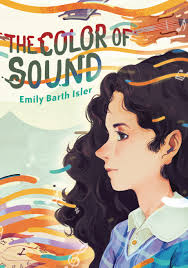Emily Barth Isler’s middle-grade book, THE COLOR OF SOUND (Carolrhoda Books, 2024), follows twelve-year-old Rosie, who has synesthesia. Although Rosie is a gifted musician, she refuses to play her violin. She also struggles with her mom and has issues with her best friend. Stuck spending the summer at her grandparents’ home, Rosie embarks on a surprising journey of self-discovery. Emily has done a remarkable job of creating an extraordinary character that readers will want to embrace. I’m excited to chat with her about her journey creating this wonderful story.
Welcome back, Emily!
Rosie is a gifted musician and she also has synesthesia, which allows her to see sound in unusual ways – in music, but also in emotions of others. On your website, you share that you also have synesthesia. How is Rosie’s experience with synesthesia different/similar to yours?
I knew when I started writing this story that I really wanted Rosie to have synesthesia, but that I didn’t want her experience with it to be exactly like mine. First of all, there are so many ways to experience the world, and there are many, many types of synesthesia. This book is fiction, not an autobiography, so I decided to make Rosie’s synesthetic experience different from mine just to separate the story from my life. But it also made a lot of sense for Rosie’s type of synesthesia to be more connected to music and colors to better serve the story– I didn’t want it to just be a detail about her, but rather an ability that actually contributes to the storytelling in a meaningful way, so that was yet another reason to differentiate Rosie’s synesthesia and mine.
While my experience with synesthesia has more to do with numbers, letters, words, and time, as well as with music, I wanted Rosie’s to help illustrate her musical gift in a tangible way for the audience, to help show how her musical gift isn’t only part of her life when she’s playing the violin, but that her connection to music is so much a part of her brain all the time.

What challenges did you face creating an authentic voice for Rosie that embraced both her adult-like abilities and experiences as a musician, and her kid-like needs for love and friendship?
In this particular way, Rosie is a lot like I was at her age. While I wasn’t a musical prodigy in the way she is, I was a “kid professional”– I worked as a professional actor, singer, and performer starting at age five, so I knew that feeling of existing in two separate worlds: the adult world of professional theater, and the kid world of school.
Now I’m a parent of tweens, and while I am VERY careful to not write about my own kids or mine from their lives, it does help me keep the writing voice for MG in mind when I’m drafting!
It was easy to slip back into the mindset of a kid who also exists in the adult world even though times have changed in the 30-some years since I was in Rosie’s shoes. The feelings and conflicting needs are still the same!
When Rosie meets a younger version of her mom, the connection helps her understand her family in new ways. Can you tell me a bit about your creative decision to use magical realism in the novel?
I didn’t originally set out to use magic in the book at all– it happened very organically and almost by accident, and I kind of went with it! It was really a lot of wish fulfillment on my part! What I wouldn’t give to meet my mom when she was the age I am now and have a real, honest talk with her in that moment! And also the reverse: the chance to bend time and talk to my kids as peers at their current ages would be so magical, too! In this case, the time glitch is a vehicle or metaphor for empathy– the literal opportunity to try and “meet someone where they are.”
For a long time, I didn’t personally gravitate towards reading books with any kind of magic or time travel, but as I’ve gotten older and seen that there are some questions in the world we just cannot answer or reason, I’ve started to appreciate a little “unexplained” in fiction. And in this case, in particular, it felt like the best way to serve the story. I wanted Rosie to come to new levels of understanding for her mom, and I couldn’t think of a better way for her to see that her mom was once a somewhat struggling 12-year-old who was also not connecting with her parents, too, than to show it, both to the readers AND to Rosie!
I think a lot of kids have a hard time picturing their parents as kids. We all know intellectually that everyone older than us was once our age and that some of the things we go through as tweens or kids are so universal, but actually imagining our parents as children is quite hard. So I wanted to take that and make it quite literal for two reasons: 1) so that Rosie could understand what her mom’s life was like at that age, but also 2) so that Rosie could see (and share with the reader) all of the ways Shanna had changed in the thirty years between them. It’s a great way to remind kids that parents and grownups are people, too– that they’re not perfect or all-knowing or always wise, that they have hurts and heartaches, too. That parents and grandparents make decisions and choices we sometimes can’t understand because they’re reacting to things we don’t know about. I hope it helps readers develop some empathy and compassion. They don’t need to forgive their elders’ mistakes, per se, but to understand them a little better.

Rosie’s family has a lot of secrets, and only when they are shared can the family heal from past hurt, some that stems from the Holocaust. Why do you think it’s important for young readers to understand generational trauma?
I think we are learning more and more how we both literally and figuratively are made up of all of the experiences and characteristics of our ancestors! When we think about genetics, we think blue eyes or brown, blond hair or big ears or a proclivity for sports or music. If our genetics hold all that code, what other gifts and traumas is it also conveying? Science has come so far in the last generation or two, and there’s still a lot we don’t understand about epigenetic inheritance.
Regardless, our genetics are only part of the story– it’s the old nature vs. nurture debate, too. I think many parents– myself included– sometimes find ourselves parenting in reaction to the ways we were parented. We think we’re consciously picking and choosing the wisdom we want to impart to our kids and, if privileged enough to do so, carefully and methodically creating an environment and routines that will give our kids a certain feeling of security or responsibility or whatever it is we’re going for. But of course there are also the things we impart unconsciously, the things we carry with us that we don’t know we’re bringing into the picture, or maybe we do but we don’t understand how we’re repeating some of the same patterns.
I loved delving into this line of thinking while writing the book, and hope that it resonates with both kids reading the book, and the adults– teachers, parents, etc., who will read and discuss it alongside them!
Thank you, Emily!
Emily Barth Isler is an author of essays and children’s books, including the middle grade novel AfterMath and the forthcoming picture book Always Enough Love. Emily writes regularly about sustainability, organic/eco-friendly skincare, and healthy beauty products for magazines and blogs. Her next book, The Color of Sound, features a character who, like Emily, has synesthesia. She has a BA in Film Studies from Wesleyan University and lives in Los Angeles with her husband and their two children.